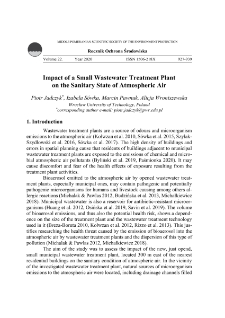Biblioteka Cyfrowa Politechniki Koszalińskiej contains 2 041 digital objects
Object
Title: Impact of a small wastewater treatment plant on the sanitary state of atmospheric air
Alternative title:
Wpływ małej oczyszczalni ścieków na stan sanitarny powietrza atmosferycznego
Description:
Place of publishing:
Publisher:
Identifier:
oai:dlibra.tu.koszalin.pl:1808
Language:
Is part of:
Rocznik Ochrona Środowiska. Vol. 22, s. 927-939
Rights:
Biblioteka Politechniki Koszalińskiej
Access rights:
License:
Object collections:
- Biblioteka Cyfrowa PK > Open Access
- Biblioteka Cyfrowa PK > Zeszyty naukowe > Rocznik Ochrona Środowiska > Vol.22
- Biblioteka Cyfrowa PK > Zeszyty naukowe > Rocznik Ochrona Środowiska > Vol.25
Last modified:
Oct 18, 2023
In our library since:
Oct 18, 2023
Number of object content hits:
74
All available object's versions:
https://dlibra.tu.koszalin.pl/publication/1812
Show description in RDF format:
Show description in OAI-PMH format:
| Edition name | Date |
|---|---|
| Jadczyk, Piotr, 2020, Impact of a small wastewater treatment plant on the sanitary state of atmospheric air | Oct 18, 2023 |
Objects Similar
Bulski, Karol Frączek, Krzysztof
Sówka, Izabela Grzelka, Agnieszka Bezyk, Yaroslav Miller, Urszula Wroniszewska, Alicja Merenda, Beata
Bolińska, Marta Iwona Siemieniuk, Anna
Sobczyński, Piotr Miller, Urszula Sówka, Izabela
Popenda, Agnieszka Bajdur, Wioletta
Xu, Lingjuan Sun, Fengqi Han, Xiuyan
Ochnio, Luiza Koszela, Grzegorz Rokicki, Tomasz
Domagała, Joanna Zych-Lewandowska, Maria


